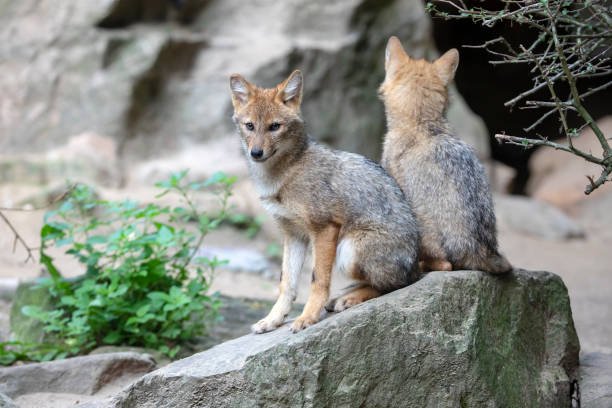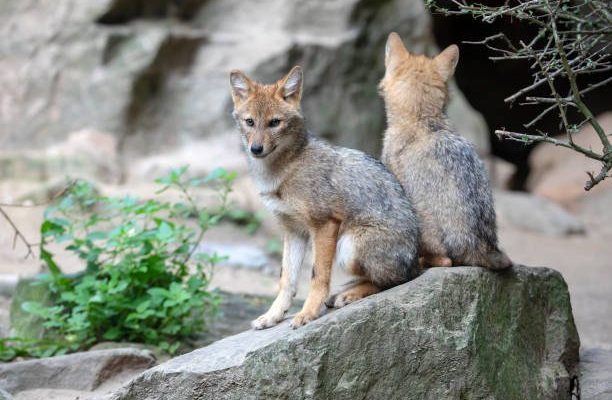
Golden jackals are found in a variety of habitats, from forests to open savannahs. They thrive in many parts of Africa and Asia, demonstrating their adaptability. Think of them as the versatile family members of the canine world, skillfully melding survival with the intimate bond of parenthood. Let’s dig into the details of how these remarkable animals raise their young.
Understanding Golden Jackal Family Structure
Golden jackals, like many canids, form strong social bonds. They usually live in small family groups, consisting of a breeding pair and their offspring. This tight-knit community structure is essential for the survival of their young. The breeding pair works as a team, taking turns caring for their pups and ensuring they are fed and protected.
The social dynamics of a jackal family can be quite interesting. Each member plays a role, from hunting for food to keeping watch over the den. You might think of it as a well-coordinated team effort. When it’s time to hunt, the adults go out together, often returning with food to share among the family. This teamwork not only strengthens their bond but also increases the chances of survival for the pups.
Their vocal communication is another crucial aspect of their family life. Jackals have a range of calls to signal different messages, from warning about potential dangers to coordinating hunts. These sounds create a sense of security and togetherness, helping the pups understand their environment and what it means to be part of a family.
Den Selection and Preparation
Choosing the right den is a big deal for golden jackals. The den provides a safe place for the pups to be born and grow. Usually, they’ll dig a burrow in the ground or use an abandoned burrow from another animal. This location is often hidden in thick vegetation or rocky areas, which makes it tricky for predators to find.
Once a den is selected, the parents prepare the space. They’ll clean it out and line it with soft materials like grass or feathers to keep their pups cozy. This prep work is crucial—just like how we make a nursery ready before a baby arrives. A comfortable den helps the pups thrive in their early weeks, giving them a warm and secure environment.
The den also serves another purpose: it’s a safe haven from predators. In the wild, dangers lurk everywhere, from larger carnivores to human activities. Thus, the parents stay vigilant, often taking turns to watch over the den while the other goes hunting.
The Birth of the Pups
Puppies are typically born in litters of about two to six, with a gestation period of around 60 to 63 days. When the time comes for the mother to give birth, she’ll find a secluded spot within the den, ensuring minimal disturbance. The excitement and emotion of this moment are palpable, as the parents prepare to welcome their new family members into the world.
After the pups are born, they are completely helpless—eyes closed and unable to walk. The mother dedicates her time to nursing them, which is crucial for their growth. Pup feeding isn’t just about providing milk; it’s about bonding. You might say it’s their first lesson in love and trust.
As they grow, the parents gradually introduce the pups to solid food. At first, it’s bits of meat brought back from hunts. This gradual shift is almost like introducing a baby to new flavors of food—slowly yet safely.
Teaching Survival Skills
Once the pups reach about three to four weeks old, they start to venture outside the den. This is an important time for their development. The parents encourage exploration but also teach basic survival skills. Think of it as a hands-on workshop about life in the wild.
The pups learn through play and observation. They mimic their parents when they are hunting, practicing their skills with each other. This playful behavior is essential; it helps them develop the instincts they will rely on later in life. In a way, it’s a natural classroom where they soak up knowledge about the world around them.
As the pups grow older, the parents begin to involve them in hunts. This is a big step in their learning process. Here’s the thing: teaching them how to be effective hunters ensures that when they become independent, they can survive on their own.
Roles of Siblings in the Raising Process
Sibling relationships play a significant role in the lives of golden jackals. Older siblings often participate in caring for the younger ones, which can include playing with them and even helping with feeding in the early stages. You might think of it as a built-in babysitting service!
This sibling support system is beneficial for both the pups and the parents. It relieves some of the pressure off the parents, allowing them to focus on hunting and gathering food while ensuring their young are entertained and safe. Plus, the pups learn valuable social skills through these interactions, which will be essential as they integrate into the larger pack later on.
Sometimes older siblings may even lead the younger ones during explorations or teach them how to find food. This dynamic builds a stronger family unit, creating bonds that can last a lifetime.
Challenges and Threats in the Wild
Life for golden jackals isn’t all sunshine and play. They face numerous challenges in the wild that can threaten their young. Habitat loss, competition with other predators, and human interference are just a few of the difficulties they encounter.
Predators such as larger carnivores can pose a significant threat, especially when the pups are young and vulnerable. The parents need to be constantly vigilant to protect their family. You could say it’s like being a protective parent in a busy city—always on the lookout for safety.
Additionally, habitat destruction due to agriculture or urban development limits their living spaces. If they lose their homes, finding food becomes increasingly challenging, impacting the entire family unit. This reality highlights the importance of conservation efforts for these incredible animals and their ecosystems.
The Lifespan and Independence of Jackals
Golden jackal pups typically remain with their family until about 6 to 10 months old. By this time, they have developed enough skills to begin their journeys into independence. As they approach this age, you might say they are ready to spread their wings and explore new territories.
Once they leave their family, they’ll often establish their own territories. Here’s where things get interesting—these young jackals may form new packs, sometimes keeping family ties intact, while at other times branching out completely. This mixing and matching of social bonds help maintain genetic diversity within their population.
While the lifespan of golden jackals in the wild averages around 10 to 14 years, their experiences during those early months build the foundation for a successful life. The skills they acquire from their parents and siblings prepare them for the challenges of adulthood.
In conclusion, the life of golden jackals is a beautiful blend of nurturing, teamwork, and adaptability. From den choices to survival skills, every step of raising their young showcases their remarkable social structure. Understanding how these animals operate not only deepens our appreciation for wildlife but also emphasizes the importance of preserving their natural habitats.

